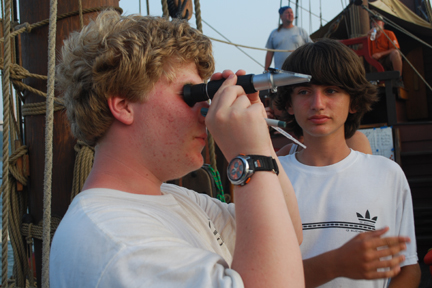
Salinity levels have an immediate effect on the surrounding ecology, since many aquatic creatures can survive only in either marine, brackish, or fresh environments. It's just as important for sailors (of any era), who need a fresh water supply to survive.
To measure the salinity gradient, our students collect water samples at regular intervals. On the Half Moon, we collect surface water samples the old-fashioned way: by simply heaving a tethered canvas bucket overboard and hauling it back on board.
Students use a refractometer (pictured above) to measure salinity levels using refraction: the degree to which light bends as it passes through different materials. Saltier water bends light farther than fresher water, so a trained refractometer user can check salinity levels with just a glance.
Sailors on board the original Half Moon in 1609 would have had to simply go by taste.
On this leg of the voyage, the research team of Annalise, Connor, and Jon studied salinity for their presentation project. They collected their first water samples on Day Two as the Half Moon traveled down the East River. Over the next two days, they continued collecting samples on a regular basis as the ship entered the Hudson River and traveled to Constitution Island in the Hudson Highlands.
|

